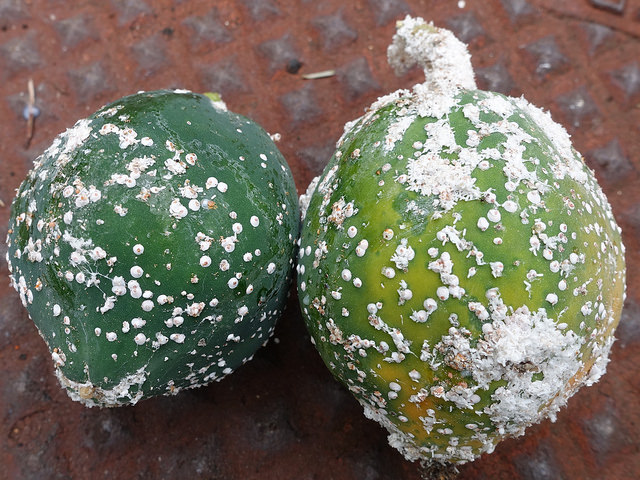Introduction
White peach scale (Pseudaulacaspis pentagona), also called white scale, West Indian peach scale, and oleander scale, is an armored scale insect that infests various stone fruits and ornamental plants. It is considered an important economic pest of peach trees. White peach scale is capable of proliferating rapidly. When populations are dense, host plants may be partially or completely defoliated, resulting in significant twig and branch dieback. White peach scale infestations may eventually culminate in plant mortality.
Distribution & Habitat
White peach scale occurs primarily in the southeastern United States. It has been found in states west to Texas, and in the Northeast, up to Maine.
Hosts
White peach scale most frequently infects peach trees. It can also infect other stone fruits, and is partial to numerous ornamental plants, including catalpa, Chinaberry, flowering cherry, mulberry, paper mulberry, and privet.
Description
The eggs produced by white peach scale range in color from orange to white. The color denotes gender, with orange indicating the development of a female, and white representing a growing male. Adult males resemble large gnats. They can reach 0.5 to 1 mm in diameter, with a 1.4 to 1.6 mm wingspan. The males construct an elongated, snow white to yellow armored shell, which conceals them from predators while they feed. At first, the males are white in coloration. As the males mature, they turn orange. The males possess wings and two tail filaments, traits that the females lack. The females are oval in shape. They are larger than their male counterparts, measuring between 1 and 2.5 mm in diameter. Their bodies are colored white to yellow. The armored shell formed by the females is typically more flattened. Both genders have mouthparts that combine to form a stylet. The scale use their stylets to feed on host plants.
Life Cycle
In the northern part of its range, white peach scale produces two generations per year. In the southern part of its range, where temperatures tend to be warmer for longer periods, white peach scale may have up to four generations per year. White peach scale passes through three stages during its life cycle: an egg stage, a larval stage, and an adult stage. After mating from late summer to mid fall, the females that have been fertilized overwinter on their hosts, beneath their armored coverings. They resume activity in spring. Each female deposits up to 150 eggs on the surface of their hosts. After the females have laid their eggs, they expire. The eggs hatch within 3 to 5 days, revealing masses of larvae. The larvae, also referred to as crawlers, seek out locations on the host to settle down and feed. The males tend to remain close to the waxy coverings of their mothers. The females stray farther, often navigating to other sections of the plant. Once the crawlers have settled, they penetrate into the plant with their stylets, and commence feeding. Within 7 to 9 days, the crawlers molt for the first time, passing into their second instars. As they continue to feed, the crawlers secrete a waxy material, which they use to craft their armored scales. The females molt once more before reaching maturity. The males progress through four additional instars prior to morphing into adults. Once mature, the males use their wings to search for potential mates. The females secrete a pheremone that guides the males to them. After they have mated, the males die. Adult males typically only live for 1 day. The second generation, or summer brood, hatches from late July to early August, with a third generation emerging in early September, followed by a fourth in October. When cool temperatures prevail, any crawlers that have not fully matured settle down to overwinter, or perish in the frost. Mature females that have mated also overwinter.
Symptoms of Infestation
When a group of males have congregated on a host, the plant will often assume a fluffy, white appearance. This is caused by the abundance of scale coverings crafted by the insects. White peach scale is a voracious feeder. It feeds by extracting plant fluids from the host. As the host’s fluids are depleted, its photosynthetic process is disrupted. When this occurs, the host’s leaves wilt and prematurely yellow, before being cast. Severe infestations will often result in extensive foliar dieback, following by plant mortality.
Management
- Several natural predators feed on white peach scale, limiting their populations. Some of the most common include ladybird beetles, lacewings, certain gall midges, a predaceous thrip, and a predaceous mite.
- Plants that have been weakened due to environmental stressors or injuries they have sustained are more prone to infestation from white peach scale. As such, ensure that plants are sufficiently watered, especially during extended periods of drought.
- Avoid mechanical injuries to vulnerable plants.
- Fertilize healthy plants to maintain their vigor, and encourage new growth. Avoid fertilizing severely infested plants, as this can cause scale populations to increase exponentially.


